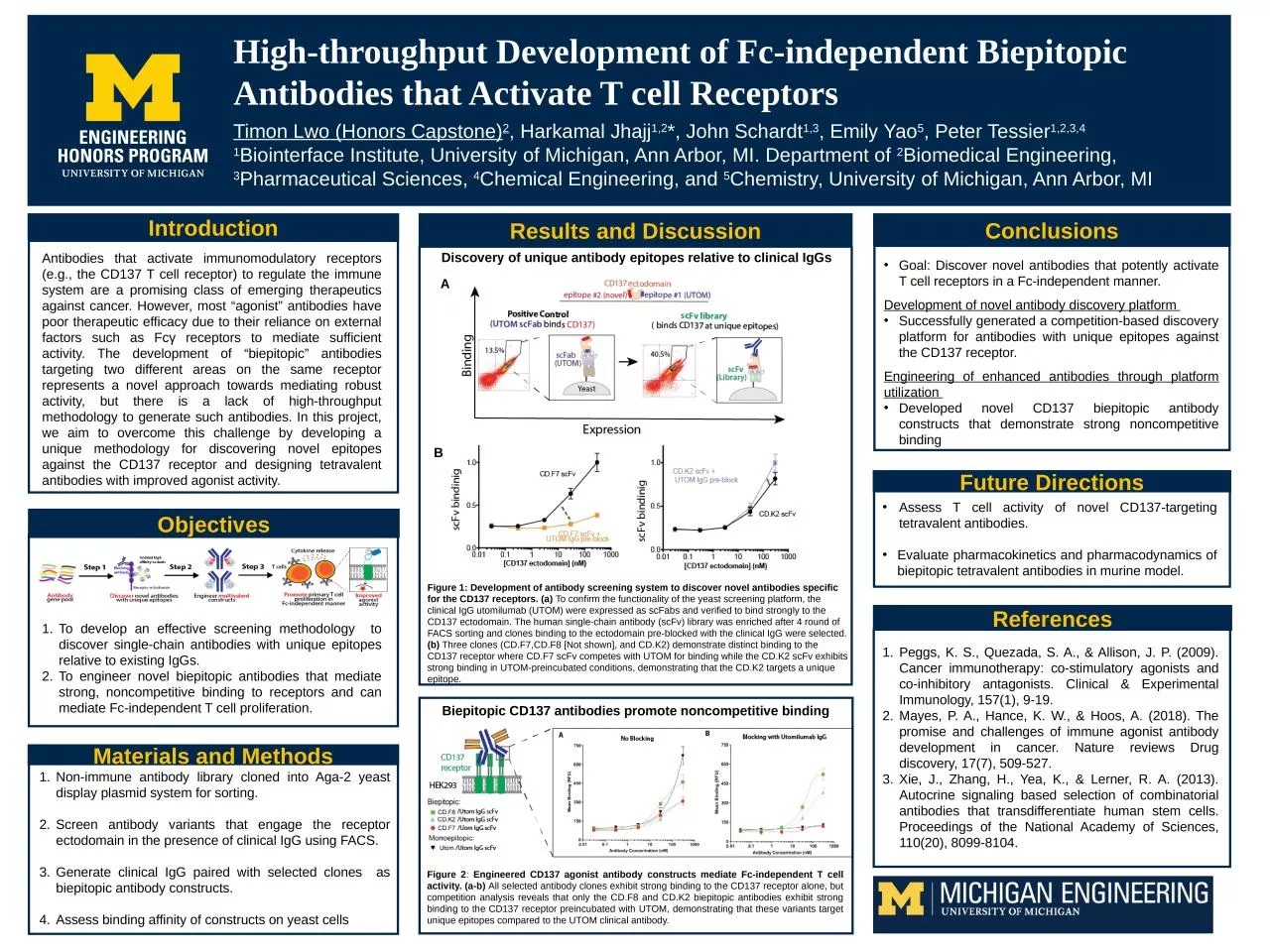

Timon Lwo Honors Capstone 2 Harkamal Jhajj 12 John Schardt 13 Emily Yao 5 Peter Tessier 1234 1 Biointerface Institute University of Michigan Ann Arbor MI Department of ID: 1033737
Download Presentation The PPT/PDF document "High-throughput Development of Fc-indepe..." is the property of its rightful owner. Permission is granted to download and print the materials on this web site for personal, non-commercial use only, and to display it on your personal computer provided you do not modify the materials and that you retain all copyright notices contained in the materials. By downloading content from our website, you accept the terms of this agreement.
1. High-throughput Development of Fc-independent Biepitopic Antibodies that Activate T cell ReceptorsTimon Lwo (Honors Capstone)2, Harkamal Jhajj1,2*, John Schardt1,3, Emily Yao5, Peter Tessier1,2,3,41Biointerface Institute, University of Michigan, Ann Arbor, MI. Department of 2Biomedical Engineering, 3Pharmaceutical Sciences, 4Chemical Engineering, and 5Chemistry, University of Michigan, Ann Arbor, MIAntibodies that activate immunomodulatory receptors (e.g., the CD137 T cell receptor) to regulate the immune system are a promising class of emerging therapeutics against cancer. However, most “agonist” antibodies have poor therapeutic efficacy due to their reliance on external factors such as Fcγ receptors to mediate sufficient activity. The development of “biepitopic” antibodies targeting two different areas on the same receptor represents a novel approach towards mediating robust activity, but there is a lack of high-throughput methodology to generate such antibodies. In this project, we aim to overcome this challenge by developing a unique methodology for discovering novel epitopes against the CD137 receptor and designing tetravalent antibodies with improved agonist activity. IntroductionGoal: Discover novel antibodies that potently activate T cell receptors in a Fc-independent manner. Development of novel antibody discovery platform Successfully generated a competition-based discovery platform for antibodies with unique epitopes against the CD137 receptor.Engineering of enhanced antibodies through platform utilization Developed novel CD137 biepitopic antibody constructs that demonstrate strong noncompetitive bindingConclusionsFuture DirectionsAssess T cell activity of novel CD137-targeting tetravalent antibodies.Evaluate pharmacokinetics and pharmacodynamics of biepitopic tetravalent antibodies in murine model. ReferencesPeggs, K. S., Quezada, S. A., & Allison, J. P. (2009). Cancer immunotherapy: co‐stimulatory agonists and co‐inhibitory antagonists. Clinical & Experimental Immunology, 157(1), 9-19.Mayes, P. A., Hance, K. W., & Hoos, A. (2018). The promise and challenges of immune agonist antibody development in cancer. Nature reviews Drug discovery, 17(7), 509-527.Xie, J., Zhang, H., Yea, K., & Lerner, R. A. (2013). Autocrine signaling based selection of combinatorial antibodies that transdifferentiate human stem cells. Proceedings of the National Academy of Sciences, 110(20), 8099-8104.Figure 1: Development of antibody screening system to discover novel antibodies specific for the CD137 receptors. (a) To confirm the functionality of the yeast screening platform, the clinical IgG utomilumab (UTOM) were expressed as scFabs and verified to bind strongly to the CD137 ectodomain. The human single-chain antibody (scFv) library was enriched after 4 round of FACS sorting and clones binding to the ectodomain pre-blocked with the clinical IgG were selected. (b) Three clones (CD.F7,CD.F8 [Not shown], and CD.K2) demonstrate distinct binding to the CD137 receptor where CD.F7 scFv competes with UTOM for binding while the CD.K2 scFv exhibits strong binding in UTOM-preincubated conditions, demonstrating that the CD.K2 targets a unique epitope. Results and DiscussionABDiscovery of unique antibody epitopes relative to clinical IgGsNon-immune antibody library cloned into Aga-2 yeast display plasmid system for sorting.Screen antibody variants that engage the receptor ectodomain in the presence of clinical IgG using FACS. Generate clinical IgG paired with selected clones as biepitopic antibody constructs.Assess binding affinity of constructs on yeast cellsMaterials and MethodsTo develop an effective screening methodology to discover single-chain antibodies with unique epitopes relative to existing IgGs.To engineer novel biepitopic antibodies that mediate strong, noncompetitive binding to receptors and can mediate Fc-independent T cell proliferation.ObjectivesBiepitopic CD137 antibodies promote noncompetitive bindingFigure 2: Engineered CD137 agonist antibody constructs mediate Fc-independent T cell activity. (a-b) All selected antibody clones exhibit strong binding to the CD137 receptor alone, but competition analysis reveals that only the CD.F8 and CD.K2 biepitopic antibodies exhibit strong binding to the CD137 receptor preincubated with UTOM, demonstrating that these variants target unique epitopes compared to the UTOM clinical antibody.